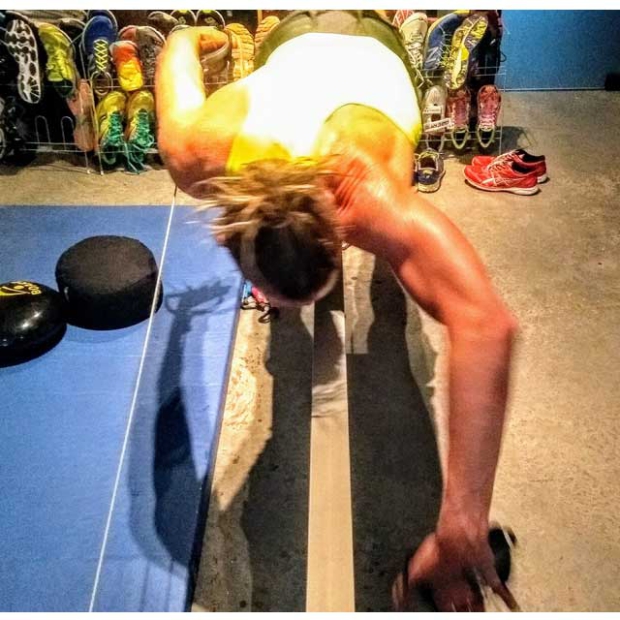My colleague Herbert Krabel interviewed Sam Gyde some weeks back, just after his men's 40-44 win at Ironman Texas. Herbert asked him how the week went, and Sam said he engaged in a couple of "open water swims in Lake Conroe since we didn’t swim since Kona.”
Wait. Back up. "You mean the first open water swim since Kona or the first swim… period?”
The latter. He spent, “Eighty-five hours on the VASA indoor trainer, and during the 2 weeks before [Texas] I spent 7 hours in an Endless Pool to get some feel for the water.”

Sam was on his bike after about an hour and 5 minutes. He’s an adult onset swimmer, so, he never was a speedburner. (Only 22 percent of Slowtwitchers come from a competitive swim background.) He is, pretty much, a typical age grouper, except he finishes his Ironmans with an 8 as the first number (Hawaiian Ironman included). Since he is us – amplified – I asked for a little color on this VASA training of his. One thing I noticed, beyond what he said, is the attachment to technical precision in the still images his girlfriend took of him aboard his VASA (note the high elbow anchor).
SLOWTWITCH: You are the patron saint for the swimming-is-a-waste-of-time crowd. Can we hash out what this means? You do your swimming mostly on a VASA unit. Can you tell us, first, whether it’s a trainer or an ergometer you use?
SAM GYDE: I am using the Ergometer. After a year I upgraded to the ant+ version of the VASA display to get my data in Training Peaks.

ST: Have you done anything to your VASA? For example, I rigged a headrest on mine for times when I'm going to spend a lot of time on it. Is yours modified at all?
SG: Nope, mine is standard. Originally I wanted to order it with the XL bench (since I am 6'3" tall) but that option was not available via the European sales channel. I don't feel the need for a headrest but my partner will occasionally put her head on the aluminum rail while VASA-ing.
ST: What is your training schedule? How many days a week? How long per workout?
SG: I aim for 4-5 sessions a week. Most session are around 4k which takes me about one-hour-five on a VASA. Short workouts are typically a 45-minute continuous session.

ST: Can you give me some idea what your workouts are like? What are a couple of sample workouts?
SG: I toss in a mix but generally I don't make things too complicated, and I put the VASA damper setting usually at 3. Usually I start with a 25'/1500m warm-up around 80-85W. After that I play with intervals and intensity/frequency/explosivity. That could be a 4 x 500 meters or a 3 x 800 meters set consisting of either:
@85-90W with damper at 7 (for strength)
@95W+ with damper at 3-4
@85-90W with damper at 3-4 (for base endurance)
That could also be 10 x 100m at 100 watts with damper at 3, for speed, followed by other interval type.
Most important is to add in enough variation, and make sure technique is okay, and add the right intervals for the right preparation period.
ST: How do you measure progress?
SG: Same as I would for the bike: Power profiling. Of course this translates to the real swimming world. So for this year my swim times are better compared to last season, both measured in time and in placings. I hope to gather enough data this year to demonstrate the relation between VASA progress ans swim progress. It helps that I always do the same races and that those races always have the same swim course.

ST: What was your swim background?
SG: In Belgium there is no swim culture so I had to learn swimming when I was about 27 years old. It has always been a struggle.
ST: How much actual swimming, in water, do you do?
SG: During races I have no choice. The week before races I try to swim a couple of times at the venue. During spring and summer I try to swim 2 to 3 times a week for 30 minutes to an hour in an Endless Pool, to engage my core and kicking for the swim, a couple of weeks before a race.
ST: Did you always train like this? Or, did you used to do a lot of swimming for triathlons? And if so, how have your swim times changed from then 'til now?
SG: I have tried everything in the pool. Numerous swim teachers, coaches, etc., have tried to help me. I have tried things like Total Immersion and SwimSmooth. I have tried with more volume, more intensity, but I always was stuck around 1 hour, 5 minutes for Ironman swims and 1 hour and 8 to 10 minutes in Kona. The combination of VASA and Endless Pool has helped me in 2 ways since we got them 2 years ago: Evaluation of stroke technique with mirrors and a GoPro giving feedback that is impossible to get routinely in a pool, so every training can be a confrontation and provide feedback; and instant intensity feedback, with power on VASA and speed in the Endless Pool.
I am realistic however: if I can gain one and-a-half to two minutes during an Ironman swim this year I will be super happy. My time available to train is very limited and if I can stick to my current swim level investing less than 5 hours per week VASAing then I will be very happy.



